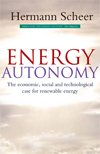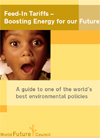 Article published in The Christian Science Monitor, August 20, 2008
Article published in The Christian Science Monitor, August 20, 2008
Interview by Mariah Blake
When you originally came up with your energy plan, even Greenpeace felt your targets were too ambitious. What made you so sure it could work?
The driving idea was that the main problem was not the development or availability of technologies. The main problem was the barriers of the conventional power structures – the monopolization of the energy supply by large power companies and the legal framework, which was designed to their interest.
We need a special renewable energy market, an open market for renewable energies. And we need to privilege them because what has no emissions, what doesn’t touch the climate, what doesn’t touch the health of the people, has a higher value for society. Giving renewable producers a privileged rate is a way to compensate for the ecological damage created by the power companies, which they don’t have to pay for.
What are the elements of a successful feed-in tariff?
To really motivate development, it’s necessary to give a guaranteed rate and to differentiate between various energy options, because they have different costs. And we have to give incentives for all renewable energy sources because the target is the total replacement of conventional energies – nuclear energy and fossil fuels.
And you think that’s possible?
The argument that it’s not possible is totally ridiculous. The sun’s rays deliver to our globe daily 15,000 times more energy than the daily consumption of nuclear and fossil energy. What we need is a mobilization of technologies to harvest this energy potential.
Beyond decentralization of energy generation, what are the key benefits of a feed-in tariff?
Firstly, you have widespread economic benefits, not concentrated in the hands of oil-producing countries and a few energy companies, but distributed within the region. This stabilizes regional economies. It also avoids environmental damage. That means it avoids costs. It promotes new industrial jobs and broad ownership, which is better for the market economy, because the market economy disappears if there are only two or three players.
There is also a psychological benefit. Each year in Germany we have 3,000 megawatts of new renewable generation coming on line. And this brings hope to many people that this gigantic problem can be solved because if people are faced with a gigantic problem and have the feeling there is no solution, it creates apathy and nihilism.



